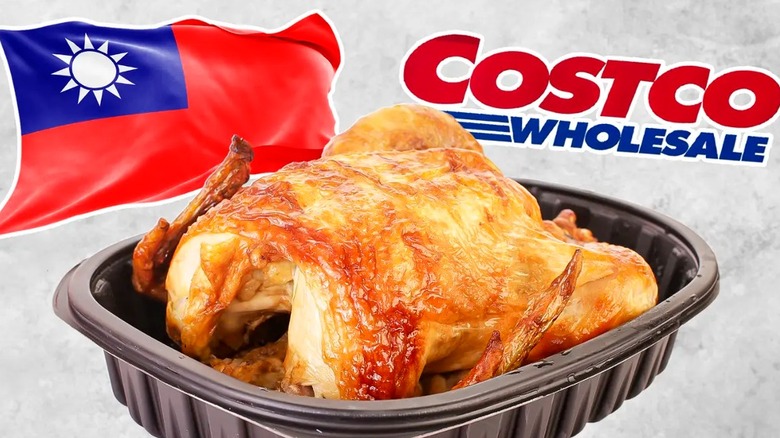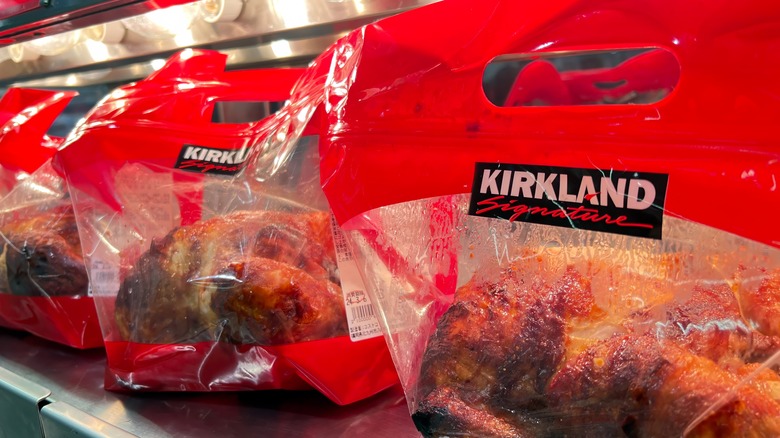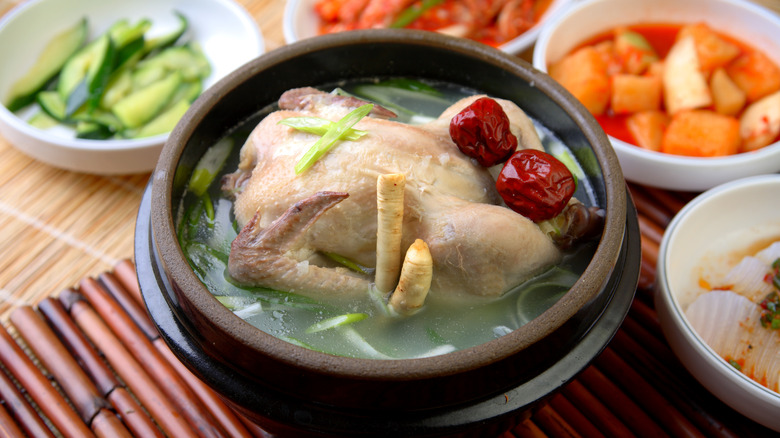Costco's Rotisserie Chickens Look A Little Different In Taiwan
Rotisserie chicken can make up a filling meal that comes together quickly on busy weeknights. Perhaps most importantly of all, the rotisserie chicken generally doesn't have surprises. Especially when it comes to Costco's rotisserie chicken — sold at the low price of $4.99 — customers typically know what to expect. They may even know useful tips for picking out the best one.
However, Costco shoppers in Taiwan may notice that rotisserie chicken appears slightly different. Available in a plastic food bag similar to the one offered in the United States, but with a flame motif, the Taiwanese Costco rotisserie chicken comes with the head still attached.
Whether chicken comes with or without its head, it seems that consumers worldwide can't get enough. Costco sold 137 million rotisserie chickens in 2023, the company's CEO, Ron Vachris, revealed in a shareholder meeting. Meanwhile, Taiwanese people are consuming record highs of poultry, primarily chicken.
While a rotisserie chicken with an intact head may be a shock to U.S. customers, it could indicate freshness to others. Either way, Costco's presentation goes to show how it adapts its offerings to different regions. In fact, learning about how different ingredients are used across the globe is a great way to appreciate culinary traditions from near and far.
Cultural symbolism of chickens in Taiwan
While the average American shopper may be wondering why Costco's rotisserie chickens are pulled from shelves after two hours, they may also be curious to learn about the roots behind the Taiwanese practice of keeping the head on a chicken. The tradition is rich in cultural symbolism, especially around the holiday season, and Costco has seemingly taken note.
For one, serving the entire chicken indicates a sense of togetherness and family unity. Specifically when it comes to the Lunar New Year, which is celebrated in Taiwan, a whole chicken can be seen as a harbinger of luck in the coming year. This belief is similar to a tradition of the American South, in which collard greens, beans, and rice are seen as symbols of luck for the New Year.
On the opposite end of the spectrum, the removal of a chicken's head is also a known ritual in Taiwan. After being accused of wrongdoing, a person would take an oath and then behead a chicken. The beheading of the chicken offered an opportunity for the accused to advocate for their innocence while providing a chance for all involved parties to discuss the conflict.
Benefits of eating the whole chicken
If you're looking to be more environmentally conscientious in the kitchen without giving up on meat, eating the whole chicken may be the right move. Food waste plays a significant role in creating harmful greenhouse gasses, but if you are eating the bird whole, fewer leftovers will be thrown out.
To get comfortable with whole chicken recipes, you could try cooking a whole poached chicken. Served with an effortless dipping sauce made with raw ginger scallion, the Cantonese dish taps into the chicken's natural flavor. If you're looking to try something more advanced, consider the black silkie chicken soup. Though the skin of a silkie chicken is dark, its flavor remains familiar. Black chicken soup is thought to contain medicinal properties thanks to Chinese herbs, ginger, and goji berries and is traditionally served to new mothers after giving birth.
Dishes like black chicken soup have nutritional benefits since chicken heads are packed with glucosamine and chondroitin, known to be beneficial for joint and hip health. Though eating a chicken head may seem daunting to some, cooking the head kills bacteria and renders the practice of eating the head safe. Whether you're looking to cut down on environmental waste or are hoping to try out new recipes, the practice of eating whole chicken could be worth introducing into your culinary routine.


